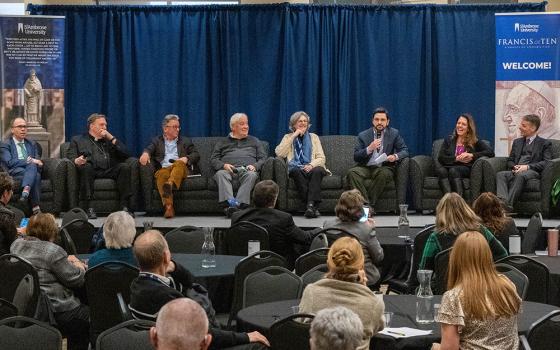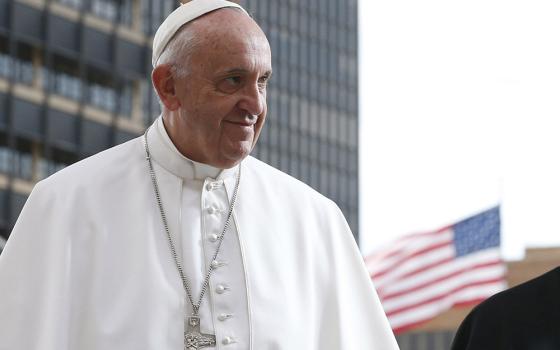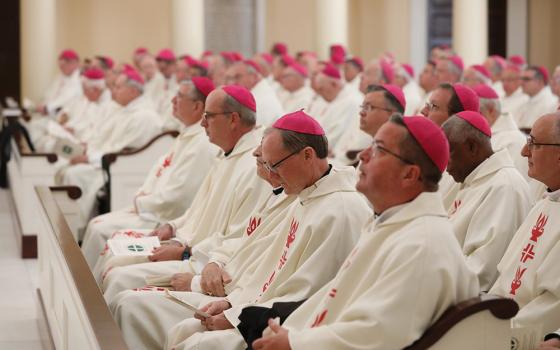
Pope Paul VI makes his way past bishops during a session of the Second Vatican Council in 1964. Vatican II, in its Dogmatic Constitution on the Church ("Lumen Gentium") promulgated by Blessed Paul VI on Nov. 21, 1964, presents succinctly the church's teaching on the role of the laity in the church and in the world. (CNS file photo)
The Second Vatican Council was a council of reform. We see this in the speeches Popes John XXIII and Paul VI delivered at the beginning of the first and second periods of the council's work. The former spoke of aggiornamento ("updating"). The second spoke of renovatio ecclesiae ("ecclesial reform"). Even using an expression of Luther, the decree on ecumenism — Unitatis redintegratio — speaks of ecclesia indiget reformation ("church needing reformation").
The ecclesial form to which the conciliar reform aimed was described by one of the most brilliant minds of Lumen gentium, Belgian Cardinal Leo Suenens. Shortly after the 1965 conclusion of the council, Suenens emphasized that the two richest elements of the ecclesiological renewal were the image of the People of God as a whole and the co-responsibility in the mission for all its members.
Deepening the spirit and the text of the council, the pontificate of Pope Francis initiates a new phase in the reception of Vatican II and recovers the conciliar image of an Ecclesia semper reformanda ("the church must always be reformed,") as he said in a morning homily at the Vatican's Santa Marta guesthouse on Nov. 9, 2013. Days later, in the apostolic exhortation Evangelii Gaudium, Francis said it is not only about revising certain church structures, but a permanent process of ecclesial conversion rooted in the ecclesiology of the people of God.
Francis began his papacy amid a church that was beginning to be global and culturally polycentric, and was inaugurating a pontificate whose roots go back to the Latin American ecclesial experience. In fact, the notion that would shape his ideal of reform at the beginning of his pontificate would come from the reception of Vatican II by two general conferences of the Latin American Episcopal Council, commonly known as CELAM. The notion is pastoral conversion.
Appearing first in the text from the 1992 CELAM conference in Santo Domingo, Dominican Republic, this notion called for a revision of "personal and community praxis, relationships of equality and authority, and structures and dynamics."
In the text from the 2007 conference in Aparecida, Brazil, the implementation of pastoral conversion responds to the model of the church as People of God and requires "an attitude of openness, dialogue and availability to promote co-responsibility and effective participation of all the faithful." Especially, the bishops were calling for "the laity to participate in the discernment, decision-making, planning and execution" of the ecclesial mission.
Pope Francis leads a meeting with the presidents and coordinators of the regional assemblies of the Synod of Bishops at the Vatican Nov. 28, 2022. (CNS photo/Vatican Media)
This does not mean that Francis' pontificate wants to implement the Latin American ecclesial model. In an interview with an Argentine news agency in July 2022, the pope emphatically said: "The things I did were not invented or dreamed up after a night of indigestion. I gathered all that the cardinals had said in the pre-conclave meetings that the next Pope should do. We said the things that had to be changed."
The preparatory document for the 2021-24 process for the Synod of Bishops points out the challenge the pope encountered, and still encounters today:
The whole Church is called to confront the weight of a culture impregnated with clericalism, inherited from its history, and forms of exercising authority in which various types of abuse (of power, economic, conscience, sexual) are inserted. A conversion of ecclesial action is unthinkable without the active participation of all the members of the People of God.
Francis is responding to this reality by means of a synodal conversion that, as the Aparecida document said, leads to "spiritual, pastoral and institutional reforms."
Reform in a synodal key
For many people, the reforms Francis has undertaken are circumscribed around the renewal of the Synods of Bishops.
One of the changes refers to praxis, extending the listening phase to the entire People of God. Examples are the two questionnaires of the 2014 and 2015 Synods on family life, the pre-assembly ahead of the 2018 Synod on young people, and the consultation of more than 80,000 people during some 270 preparatory meetings for the 2019 Synod for the nine-nation Amazon region.
Today, this is deepened by the current three-year process for the Synod on Synodality. It is the most important event since Vatican II and the broadest effort the Catholic Church has made to involve all the faithful in "the work of ecclesial renewal and reform," as described by Unitatis redintegratio.
However, to speak of a process of reform in a synodal key goes beyond the celebration of synods. It is a process of maturation of the ecclesiology that finds its foundation in Chapter II of Lumen gentium. We can speak of a reform in a synodal key because synodality is the way of constituting the church as People of God with the co-responsible participation of all.
The 2018 document of the International Theological Commission defines synodality as a constitutive dimension of the whole church because it refers to "the specific way of living and acting/operating (modus vivendi et operandi)," which implies reviewing "relationships and mentalities" (being), and "communicative dynamics and structures" (operating).
In this sense, synodality is not something optional. Francis' words to the Diocese of Rome in September 2021 are enlightening in this regard:
The theme of synodality is not the chapter of a treatise on ecclesiology, and even less a fashion, it is not a slogan or a new term to be used and instrumentalized in our meetings. No! Synodality expresses the nature of the Church, its form, its style and its mission. Therefore, we speak of a synodal Church, thus avoiding that we consider it to be a title among others or a way of thinking about it, foreseeing alternatives.
Bishops are pictured in a file photo during a Vatican II session inside St. Peter's Basilica at the Vatican. (CNS file photo)
Challenge of walking together
In his 2015 address for the 50th anniversary of the synod, Francis made this vision explicit and maintained that "the path of synodality is the path that God expects of the Church of the third millennium." He said he has invited the whole church to undertake processes of consultation, listening and discernment that contribute to building a new institutional model.
In the same speech, the pope described the new model with the following words: "what the Lord is asking of us, in a certain sense, is already all contained in the word 'Synod.' To walk together —laity, pastors, Bishop of Rome." But what does this mean?
The preparatory document for the Synod on Synodality explains that walking together can be understood from two perspectives. The first "looks at the internal life of the particular Churches" and the second "considers how the People of God walks together with the entire human family."
As the 2018 document from the theological commission states, the church "manifests and concretely realizes its communion in walking together, in gathering in assembly and in the active participation of all its members in its evangelizing mission."
This implies that any reform process must seek ways to involve the whole People of God, in its entirety, through processes of listening, communal discernment, elaboration and decision-making because, as the commission maintains, "the synodal dimension of the Church must be expressed through the realization and governance of processes of participation and discernment capable of manifesting the dynamism of communion that inspires all ecclesial decisions."
This pontificate has initiated a process of ecclesial renewal that implies a change in the understanding of the collective conscience of what it means to be church as People of God, which entails the challenge of generating new ways of relating among the ecclesial subjects (conversion), as well as the updating of existing structures and the creation of others (reform) that would allow the exercise of an effective co-responsibility of all the faithful.
This will require a new ecclesial institutional way of proceeding.
A new institutional model
Francis speaks of the new model using communicative dynamics. In his speech for the 50th anniversary of the synod, he said
a synodal Church is a Church of listening ... It is a reciprocal listening in which everyone has something to learn ... It is listening to God, to the point of listening with him to the cry of the people; and it is listening to the people, to the point of breathing in them the will to which God calls us.
The exercise of listening is indispensable for any ecclesial change because it starts from the recognition of the identity and the proper contribution of each ecclesial subject — laity, priests, religious, bishops and pope. It expresses an institutional praxis that recognizes horizontal relationships that flow from our baptismal dignity, the participation in the common priesthood of all the faithful and the exercise of co-responsibility in the mission.
The practice of listening activates a process of conversion and reform toward a new institutional model inspired by the classic principle that says: what affects all must be treated and approved by all.
Advertisement
Therefore, in a synodal church, listening takes place within the framework of a bigger process, because its purpose is not simply to meet and get to know one another better, but, as Francis described to the Diocese of Rome, to discern and elaborate pastoral decisions that will affect us all, "following what we can consider the first and most important manual of ecclesiology, which is the book of the Acts of the Apostles."
Moreover, it is a matter of listening to others, and especially the poor, "in order to know what the Spirit is saying to the Churches (Revelations 2:7)" and to find ways of proceeding in keeping with our times. Therefore, listening includes those who have different points of view, those who have not been heard or are excluded. We cannot pretend to tame the Spirit and tell it where to speak.
Synodality may be new for us, but it's not new in the long and rich tradition of the church.
We can conclude by recalling the golden rule of St. Cyprian, bishop of Carthage, which offers the most appropriate interpretative framework for thinking about today's challenges: "Do nothing without the advice of the presbyters and the consensus of the people."
For Bishop Cyprian, taking counsel from the presbyterate and building consensus with the people were fundamental experiences throughout his episcopal exercise to maintain communion in the church. He implemented methods based on listening, dialogue and discernment involving all the faithful and not only ordained ministers.
Today, Francis leaves us with this great challenge for the third millennium: to build a synodal church that lives communion based on the participation and co-responsibility of all the faithful as members of a Church People of God in a permanent state of conversion and reform.







